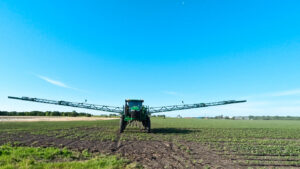Editor’s Note: Sarah Nolet is the CEO and founder of AgThentic, a global food and agriculture strategy firm, and co-founder of Tenacious Ventures, Australia’s first dedicated agrifood tech VC firm. Sarah is also the host of the AgTech…So What? podcast and co-founder of Farmers2Founders, a national innovation program that supports farmers to get involved with agtech as more than customers. She recently teamed up with Tim Hammerich, host of the Future of Agriculture podcast, to host a live discussion about agtech acquisitions with Derek Norman, vice president at Leaps by Bayer, and Jim Chambers, president and general manager of the Worldwide Agriculture Business at Trimble. You can hear the full discussion on the podcast here. Below Sarah offers some of the key takeaways.
Agtech is about creating value for end users, whether farmers or other players along the value chain. Startups that stay laser-focused on their customers, in most cases, will succeed.
But for companies that raise money, they must also focus on returns for their investors. That means keeping a path to exit on the radar. Where will these exits come from and when? How can startups get acquisition-ready? And how is the landscape changing with Covid-19?
Last week, our AgTech:Acquired conversation with Derek Norman and Jim Chambers revealed five key takeaways and tips for startups thinking about how to exit and when.
Corporate investors are different
Corporate investors and acquirers are different from venture capitalists (VCs) in that they are looking for companies that will add strategic value to their parent company – in this case, Trimble and Bayer Crop Science. But what “strategic value” means will differ for each company.
Leaps by Bayer, for example, is looking for companies that can help them find new ways to add value to growers, either to augment strengths in a current market or open a new market where they don’t currently have an offering. As a corporate venture arm, Leaps by Bayer can invest in earlier-stage companies, often co-investing with VCs.
Trimble’s strategy is different. They do not invest in early-stage startups, but rather look for acquisition opportunities. Specifically, they’re seeking companies that can drive revenue to the business in the near term without having to invest resources in further development. This approach has an implication for the maturity of companies that Trimble engages with: they are looking for products that are already commercial.
→ Startups, do your homework to understand how a potential corporate partner, whether acquirer or investor, operates and what “strategic” means to them.
Solutions open wallets, not widgets
Like all investors, strategics are looking for rockstar teams. A startup can have all the technology in the world, but without sound execution, it cannot deliver on returns or strategic objectives.
“If you look at the major acquisitions in agtech over the past 10 years, they all have great teams. So I know that’s a little bit of a cliche, but it’s true: you’ve got to have great teams that can help the companies move through all of the challenges and make the right decisions in the face of uncertainty,” said Derek (Bayer).
A strong value proposition and go-to-market strategy are also critical, especially in agriculture where the hype around agtech is high, supply chains are complex, and channels are king.
For Trimble, this means less emphasis on the technology and more focus on considerations like:
- Is the product standalone or will it be embedded (and how)?
- Is this solving a “keep you up at night” problem for a farmer?
- Do you replace something that exists, or require a change in behavior?
- What is the path to revenue, and what is the evidence that users will pay?
→ Startups, focus on your business model over your technology; solutions open wallets, not widgets.
Be patient but opportunistic: consolidation has slowed exits
Though funding into agri-foodtech has increased as the supporting ecosystems grow and more talent and capital enter the space, the sector overall is still early. That leaves a big question on everyone’s mind: why haven’t we seen more exits, and when will this change?
One reason is that corporate agribusinesses have been busy navigating the significant consolidation that has occurred in recent years. With coronavirus as an added pressure more recently, investments and acquisitions have struggled for attention and prioritization.
The good news is that both of these are likely temporary distractions. And further, there’s nothing like a good crisis to shake things up and help you think differently. Jim and Derek are keeping a close eye on changes occurring in areas such as e-commerce, indoor agriculture, and autonomy, as farmers and value chains adapt to new constraints.
One thing we may continue to see in the near term are smaller (i.e. sub $100 million) exits as corporates balance risk management with strategic opportunities.
“It’s hard to find companies that truly have the scale yet to warrant hundred million dollar valuations,” said Jim (Trimble). “We can find a lot more in the sub $50 million range. And it just seems like it’s a little easier and less risky because when we get north of $1oo million, it’s a big deal.”
→ Startups, be patient but look for opportunities arising out of tough times.
Beware of post-acquisition pitfalls
In the startup world, there is a lot of talk about what it takes to raise money and get to an exit, but what happens next? Jim, having been on both sides of multiple exits in agriculture, has a few tips.
First, startups need to consider how they will fit with the acquirer. What will happen after your technology is embedded into their product? What role will you play in the larger organization?
Startups must also realize that they are no longer in charge. As an entrepreneur, you get to flex or even change the rules. But post-acquisition, you may be limited to offering opinions into someone else’s strategy. As Jim says, “you have to realize that when you get acquired, you need to play the company’s game, not your own game.” Adjusting is critical, as otherwise hitting targets or milestones that were set during the acquisition process can be tough.
→ Startups, consider more than just the exit and get ready for things to change.
The squishy stuff is important
With so much talk about acquisitions, it’s easy to forget that these transactions are ultimately all about people and relationships. Buyers are taking a risk, dedicating time and money, and de-prioritizing other activities to advocate for the deal. As Derek explains, they genuinely care about its success: “there’s nervousness but also a sincere earnestness to make everything work.”
This means trust is absolutely critical; without it, the deal will not get done. Navigating the difficult conversations that inevitably occur during investment or acquisition discussions is an important way to build trust. It’s a chance for both parties to evaluate each other under pressure and hopefully begin to build the foundations of a lasting relationship.
→ Startups, every tough conversation is an opportunity to build a lasting relationship.
To hear the full conversation with Jim and Derek, and for more on the “so what” of agtech, check out the podcast here.



